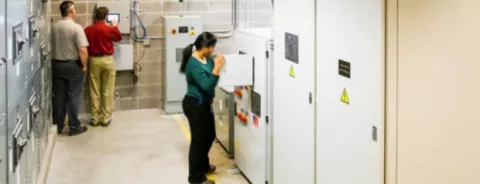
Energy storage for the microgrid at Black & Veatch headquarters.
There was a time, and it wasn't that long ago, when solar and wind energy were greeted with skepticism and outright resistance from most traditional electric utilities. But look around. Rooftop solar has taken off, and has done so well that in many areas solar is near parity with the electric grid.
Experts from Black & Veatch, a Council Associate Partner, are betting that energy storage will take the same level of growth. "The development of economic, reliable energy storage systems is the missing link in the deployment of renewable energy," said Ralph Romero, director of the firm's management consulting business.
Storage has indeed come a long way. In late 2013, the California Public Utilities Commission told the state's three investor-owned utilities to have 1,325 megawatts of energy storage online by 2020. As Black & Veatch says, those requirements have been exceeded in at least one instance, which the company's Mark Manley says indicates how strong the new market is and how much interest there is in it. Manley is Manager of Black &Veatch’s management consulting business.
Growing pains
"Given that storage is now where solar was five to 10 years ago, there are lots of new start-ups and technologies. However, there is also little standardization, lots of buzz and a lack of information as to what is out there and what the technology actually represents," Romero said. That makes it tough for engineers and developers to figure out how much storage they need and which system to use. There are also nagging questions about whether a storage system based on a specific technology will live up to its billing and perform as well and for as long as expected.
But remember earlier versions of wind and solar power systems had their own flaws and obstacles –- and energy storage is facing many of the same issues. Wind and solar solved most of their problems and there's no reason to think energy storage technology developers can't do the same.
Storage really is catching on
As solar photovoltaic technology advances and becomes yet more popular, Black & Veatch expects energy storage to go along for the ride. And in return, energy storage will help solve the inherent variable nature of solar. The sun doesn't shine when it may be needed most, but storage systems can charge up when demand is low and discharge power when it's needed during periods of peak demand.
Low or no upfront cost financing options are feeding the popularity of rooftop solar, making it more accessible for more people. And solar plus energy storage systems are already becoming more widely available. Earlier this year, for example, Daimler AG started offering Mercedes-Benz-branded EV batteries for private use. Intended to be used as energy storage for home solar power plants, the Mercedes-Benz units are up to eight battery modules combined into a storage system with a 20 kilowatt-hour capacity. Mercedes-Benz is a Council Lead Partner.
What's in it for cities?
In their quest for sustainability, many cities have adopted renewable energy systems -– and so have many of their electric utilities. Also, commercial operations -- a major ingredient in a city's economic vitality – are interested in energy storage. Why? Because it can help them save money on the often substantial demand charges they pay. With an energy storage system, a company can keep some power in the bank during off-peak use and tap into it later -- and save money because of the way those demand charges are levied.
###
Doug Peeples is a Portland, Oregon-based writer specializing in technology and energy. Follow @smartccouncil on Twitter.
Related articles…
Breakthrough for EV charging and energy storage?
Rural Zambian schools powered by S&C Electric solar plus energy storage solution



